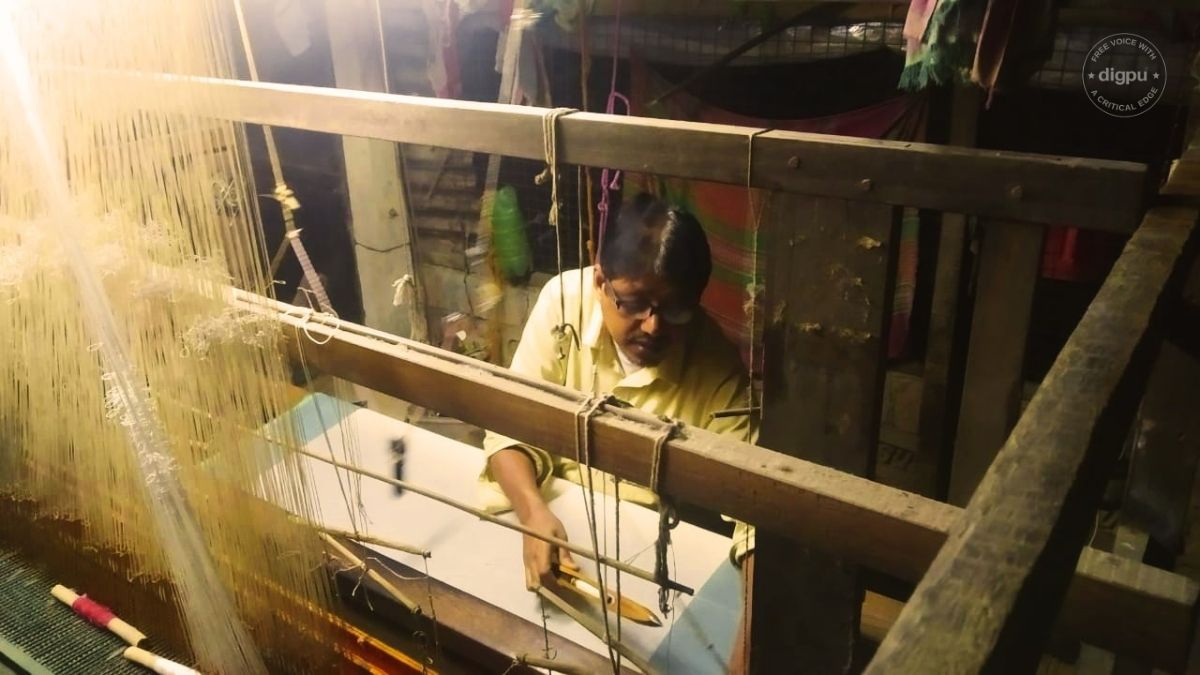Weavers in Nadia's Shantipur and Phulia left at the mercy of God

Most of the weavers who come from Assam and other districts in Bengal could not join work in Nadia's Phulia due to COVID-19
The majority of handlooms in Phulia are collecting dust for days now. Perhaps, the last fine piece of Tant saree is now being woven, endangering a 500-year-old weaving tradition in West Bengal’s Nadia district.
After partition and Bangladesh riots, many weavers from present-day Bangladesh crossed borders and settled down and set up looms in the small towns of Shantipur, Phulia and many more in the Nadia district. Gradually, both Shantipur and Phulia became the hub of cotton (handloom) Tant sarees.
But now, the demand of these weavers is slowly fading away who were once famous for their bold-red, yellow and deep-blue sarees with their decorative borders and pallus, and often with small butis (leaf-like motifs) on them.
The Covid and lockdown, to arrest the speed of the spread, has affected these weavers even more.
Both Covid and power loom are the cause of distress
The weavers of Bengal’s Phulia are in deep crisis in the wake of Covid. Most of the weavers who come from Assam and other districts in Bengal could not join work. Usually from Cooch Behar alone, 10,000-15,000 weavers come to Phulia. Thus, it has created a shortage of weavers in Phulia.
Adding to their problems is the rapid expansion of power looms and rapier. According to the locals, there were more than a lakh weavers in Shantipur and Phulia. But currently, there is only 60,000 of them.
A weaver will take two days to weave a simple cotton Tant saree in a handloom. Daily, more than 30 sarees are made in power looms and rapiers with just one weaver. As a result, their Tant is much less expensive than a handloom Tant. It is having two-way effects on handloom weavers.
https://www.youtube.com/watch?v=n5C7QpKk698&feature=youtu.be
The two-way effect
Firstly, they are losing their jobs or are forced to work for lesser pay. Usually, these weavers are the sole earning members of the families. Overall, this is affecting their family's financial health grievously. Some of them are also taking up other jobs, putting this profession in the face of extinction. While the regular sarees take about two days to complete, a designer Tant saree would take around six months to a year to finish weaving.
But most of them can't get a decent job due to a lack of education. Weaver Rabindranath Basak has just managed to get primary education. “I have started working at the early age of eight with my father. I could barely study till Class 5 or 6,” he said. The new generation has started working as farmers or daily wage labourers or has shifted to a bigger city to try their luck.
Secondly, their products do not get their due. As cheap copies and power loom products have captured the market, they are often forced to sell their sarees at much lesser prices.
"The power and rapier looms are now spreading fast. In rapier looms, 32 sarees are made daily with the help of just one weaver. The same number of sarees will take a much longer time in handloom and will require at least 32 weavers,” Biren Kumar Basak, who was awarded Padma Shri in 2021 in art and culture, said.
Tant weaving is a cultural art of India, especially in eastern parts of the country. Patit Basak is weaving a Tant saree alone in a room where three other wooden looms are sitting idle, collecting dust.
The solution to the weaver crisis
The populist government of Bengal has announced a slew of measures for them. They have given them free looms to work on. But it does not have any concrete and collective development measures for them.
“The government is not looking after this problem. I have talked with West Bengal Chief Minister, Union Minister Smriti Irani about the same. I have also talked about the problem with PM Modi,” Biren Basak said.
According to Union Minister Smriti Irani, it is hard to separate the handloom and power loom sarees. Also, the country has 80% power looms and only 20% active handlooms.
Therefore, it is not possible to remove GST from the handloom produce as most power loom sarees are sold in the name of handloom produces. "The only solution to the problem is tagging the produce and where it is made, like done earlier,” Padma Shri Basak said.
The traditional art of weaving Jamdani, considered the best variety of Tant clothing, has been enlisted by UNESCO as an Intangible Cultural Heritage of Humanity. Not getting their due deserve, the art is now converted as the subjugation of the power loom and rapier Tants.
https://www.digpu.com/?p=125317
Comments
Post a Comment